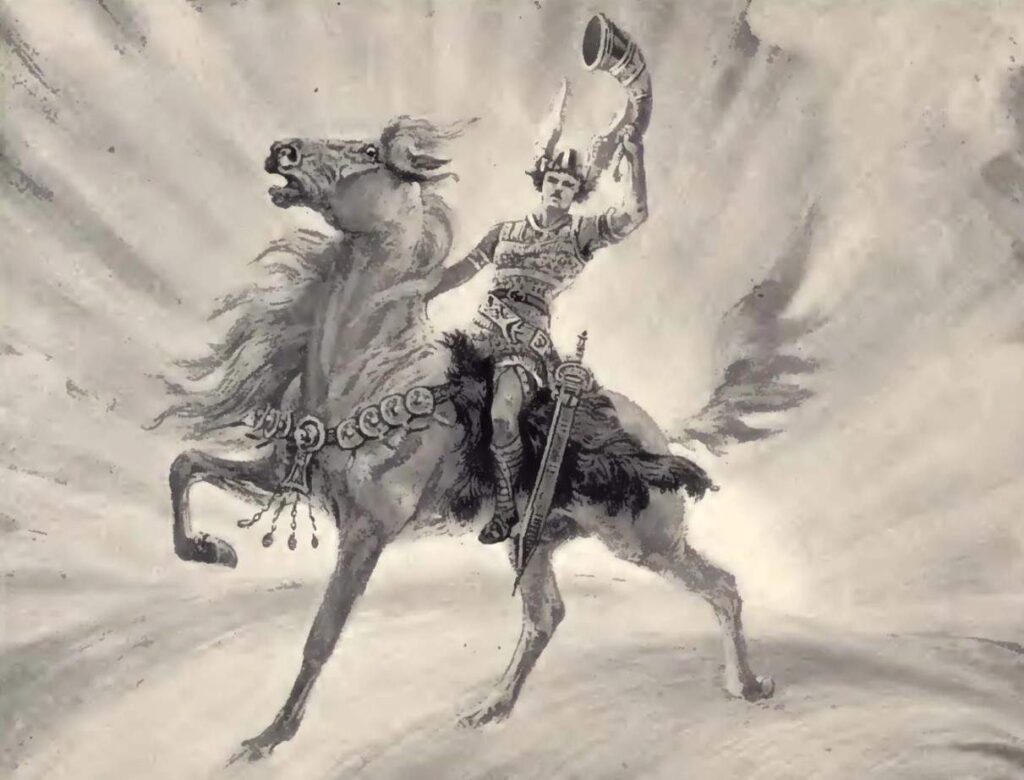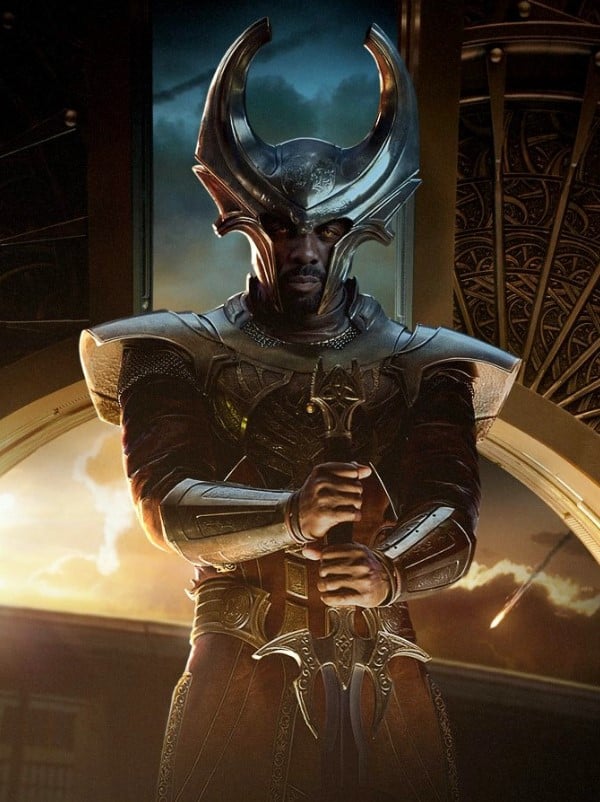Hofund: The Epic Sword of Norse Mythology
In a realm where gods and giants clash, and legends come to life, there exists a weapon of unrivaled might – the legendary Hofund. The Norse mythos, woven with tales of courage and grandeur, unfurls before us, revealing the epic saga of Hofund.
In a world where power and destiny intertwine, we embark on a journey through the realms of Norse folklore, to uncover the secrets of this legendary blade. A tale of gods and warriors, Hofund shines as a symbol of divine strength.
Who Wielded Hofund?
Hofund is wielded by Heimdall. Heimdall, a legendary figure in Norse mythology, emerges as a character shrouded in mystery and power. Born of the Vanir, birthed by nine mothers who personify the sea, Heimdall’s origins are as mysterious as the depths of the ocean itself. But his tale doesn’t stop there.
He was to be wed to Siriana of the Aesir, and a special wedding dress was even crafted to conceal him from his own perceptive gaze. However, the Aesir-Vanir War disrupted their union, and when the dust of battle settled, their marriage was never realized. Heimdall’s life holds more than a failed marriage and a mystic dress; it’s a story woven into the very fabric of Norse mythology.
Guardian of the Bifrost
Heimdall wasn’t merely a passive observer in the annals of Asgardian lore. He rose to become a valiant warrior, especially after the Storm Giants attempted to breach Asgard’s defenses. It was this very event that led to his destiny as the guardian of the Bifrost, the Rainbow Bridge connecting Asgard to Midgard.
Odin, the All-Father, chose Heimdall for his unique ability to perceive events across time, a power that allowed him to predict an imminent assault by the Storm Giants. Heimdall’s watchful eyes, sharper than any in the Nine Realms, earned him this distinguished duty.
Challenges and Failures
Although Heimdall was a formidable guardian, he wasn’t without his moments of vulnerability. A spirit known as Vanna, believed to be uncatchable, once eluded him as it embarked on a mission to spy on Asgard for the Storm Giants’ King, Brimer.
Heimdall’s vigilance wavered, and he failed in his duty. However, he did not conceal his failure but immediately reported it to Odin, enabling the All-Father to apprehend the spy. This episode demonstrated Heimdall’s unwavering commitment to his role as protector.
Heimdall and Loki
The trickster god, Loki, remained a perpetual thorn in the side of the Asgardians. Heimdall found himself inadvertently releasing Loki from his imprisonment in a tree, which Odin had decreed would last until another Asgardian shed a tear for the god of mischief.
When Heimdall passed beneath the tree, a leaf fell, striking him in the eye and causing him to shed the required tear. This event marked yet another twist in the enduring saga of Loki’s escapades.
Heimdall’s Legacy
Throughout the centuries, Heimdall stood as a stalwart guardian of the Bifrost. He served as the first line of defense, defending Asgard against external threats and contributing to the realm’s stability. He even assumed the role of ruler during Odin’s Odinsleep, demonstrating his capacity to lead and protect.
After Bifrost’s Destruction
The destruction of Bifrost after an attack by Surtur had implications for Heimdall’s duties. He used the hiatus to form a romantic relationship with Amora the Enchantress. However, when Bifrost was restored, he returned to his post as its guardian.
Post-Ragnarok and Beyond
Following the reconstruction of Asgard after Ragnarök, Heimdall was among the first Asgardians to return. In a different instance, when Thor was banished for killing Bor, Heimdall served as an advisor to Balder.
Siege and Thunder God Tanarus
In the events of the Siege, Heimdall foresaw an impending attack by Norman Osborn, but Loki intervened, preventing him from warning anyone. Heimdall engaged Osborn’s forces in battle and subsequently resumed his role as Asgard’s watchman. The era of Tanarus saw Heimdall confront suspicious circumstances and face severe consequences for his inquiry.
The Mangog’s Attack and Heimdall’s Tragic End
When the terrifying Mangog reemerged, Heimdall stood as the first line of defense to protect Asgardia. In a brutal confrontation, Mangog shattered Hofund, Heimdall’s sword, and gouged out his eyes. Despite his heroic efforts and the intervention of Jane Foster, Heimdall succumbed to his injuries.
The Far Shore
After the War of the Realms, Heimdall’s eyesight was miraculously restored, and he received his sword from Daredevil. In a fateful journey to Midgard with Jane Foster, the new Valkyrie, Heimdall met his end. However, his journey didn’t conclude with death; it transcended to the enigmatic Far Shore, unveiling a new chapter in his story.
Powers and Abilities
Heimdall, like other Asgardians, boasts a formidable array of superhuman attributes. His strength, speed, stamina, and durability far surpass human capabilities. With his dense tissue, agility, and reflexes, he is a force to be reckoned with.
His longevity, healing abilities, and the ability to regenerate damaged tissue exemplify his resilience. However, what sets Heimdall apart are his extraordinarily acute senses, which can perceive events far beyond mortal comprehension.
What is Hofund’s Origin Story and its Powers?
Forged by the skilled Dwarves of Nidavellir, it received enchantments from the mighty Odin himself. This divine weapon is not just a mere blade; it wields cosmic forces that Heimdall can command to strike down even the most formidable of foes, as demonstrated when he halted a half-powered Thor’s entry into Asgard.
With Hofund, Heimdall can harness blue flames from countless cosmic stars, rendering it a weapon of immeasurable power. Furthermore, it possesses the mystical ability to disguise its master as a mortal human, a useful skill for Heimdall during his time on Midgard.
Hofund holds yet another extraordinary power – the capability to summon the Bifrost, the fabled Rainbow Bridge that links realms. However, this legendary sword didn’t remain in Heimdall’s possession without event. At one point, it fell into the hands of the Sharzhad terrorist Abu Mussan when Heimdall descended to Midgard after the Bifrost Bridge’s destruction.
Mussan harbored ambitions of becoming the new king of his sacred land using Hofund but was thwarted by the combined efforts of the Black Knight and Valkyrie. The sword was eventually retrieved by S.H.I.E.L.D. agent Phil Coulson and returned to its rightful owner, Heimdall.
However, Hofund’s adventures were far from over. When Heimdall confronted the formidable Mangog in the entrance to Asgardia, the sword played a pivotal role in the ensuing battle. Tragically, it was broken in half by Mangog after Heimdall attempted to strike down the powerful entity.
In a surprising turn of events, Hofund was eventually repaired and passed on to Daredevil by Heimdall. This gesture was made to aid in the restoration of the Bifrost. Following the War of the Realms, Daredevil dutifully returned Hofund to Heimdall, and later it was assumed by Sif, who became the new Guardian of the Bifrost, carrying on the sword’s legacy in the defense of Asgard and the realms beyond.
Hofund as Seen in the MCU
Throughout its cinematic history, Hofund played a pivotal role in several key events:
- Protector of the Realms: Heimdall used Hofund as a key to activate the Bifrost Bridge, enabling the transportation of people and creatures across the Nine Realms.
- Frost Giants Attack: During an encounter in Jotunheim, Heimdall utilized Hofund to open the Bifrost Bridge, facilitating the safe return of Thor, Sif, Loki, and the Warriors Three.
- Loki Takes the Throne: Heimdall wielded Hofund in an attempt to confront Loki. However, he was temporarily incapacitated when Loki froze him in ice using the Casket of Ancient Winters. He later broke free and used the sword to open the Bifrost Bridge for Thor and his allies.
- Sacking of Asgard: Hofund was employed by Heimdall to activate the protective shield around Asgard during the Sacking of Asgard.
- Committing Treason: In a moment of subterfuge, Heimdall drew Hofund to distract Odin and the Einherjar while Thor, Loki, and Jane Foster made their escape in an Asgardian Skiff.
- Heimdall’s Banishment: Loki, masquerading as Odin, exiled Heimdall and entrusted Hofund to Skurge. Under Skurge’s command, Hofund was used to steal objects from Earth, and the Bifrost was exploited for various purposes.
- Hela’s Coup: In a bid to disable the Bifrost Bridge and hinder Hela’s plan to conquer the Nine Realms, Heimdall retook Hofund. He wielded the sword as a weapon, defending against Hela’s forces during her occupation of the Asgardian throne.
- Sending Hulk to Earth: Heimdall, despite his injuries, used the enchantments of Hofund to activate the Bifrost once more. He sent Hulk to Earth for safety, ultimately drawing the attention of Thanos, who killed Heimdall and caused him to drop Hofund. The sword was destroyed when Thanos used the Power Stone to implode the Statesman, the Asgardian ship.
Hofund’s capabilities extended beyond its use as a Bifrost key. It doubled as a formidable sword in combat and required no sharpening. Throughout its cinematic journey, Hofund played a vital role in the protection of Asgard, the transport of key characters across realms, and the defense against formidable foes.
Conclusion
As our adventure through the annals of Norse mythology comes to a close, we stand in awe of the magnificent Hofund, a sword that has withstood the test of time and fire. In the grand tapestry of myths and legends, this weapon remains a beacon of valor and inspiration.
Much like the heroes that wield it, Hofund represents the indomitable spirit of legends born from the realm of Asgard. Whether in ancient sagas or modern tales, Hofund is an emblem of strength, bravery, and the timeless allure of Norse mythology. It lives on, transcending eras and cultures, inspiring generation after generation as a symbol of the everlasting magic of the North.



